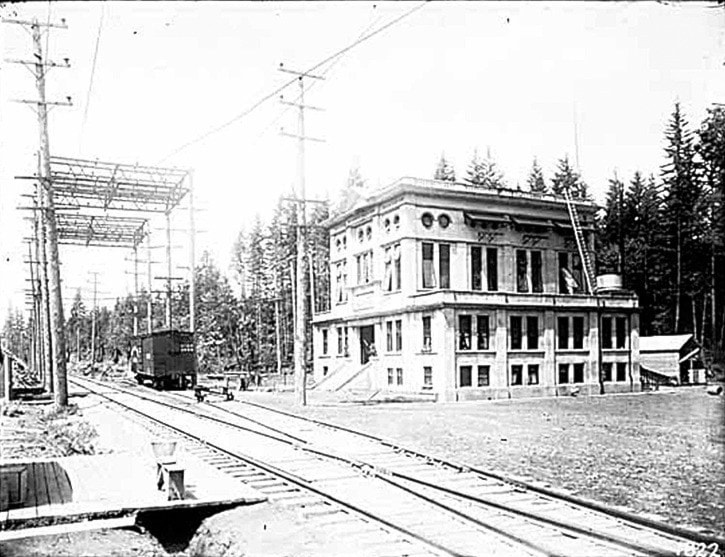It is such a formal looking structure in an unexpected location that its presence has been intriguing passersby for decades.
In November, an interpretive sign was installed by the Township of Langley to convey its history and help explain the mystery surrounding the turn of the century concrete building that can be found out in the country by the railway tracks.
Known as the BCER Langley Substation, the structure was built at 6835 256th St. by the BC Electric Railway in 1910. Historically referred to as Coghlan Substation, it supplied 600 volts of direct current to boost the interurban trains traveling between New Westminster and Chilliwack.
“It is a unique and imposing structure and many questions have been posed by curious citizens, railway enthusiasts, and tourists who have come across it,” said Township of Langley heritage planner Elaine Horricks.
The four storey building, which features early 20th century classical revival architecture, was designed by architect Henry B. Watson, who gave the industrial building a sense of grandeur and created a landmark with its unique design.
The building, which was added to Langley Township’s Community Heritage Register in October 2013, was purchased by Bryant Ross and two other artists in 1987 to use as art studio space.
Over the years it has been used by many well-known artists, including painters Norval Morrisseau, Issac Bignel, and Gerry Meeches, and Northwest Coast carvers Gene Brabant and the Hunt Family. It is now a gallery called Coghlan Art, which features contemporary Native wood carvings, paintings, and prints from the Pacific Northwest Coast.
Since taking over the building, Ross has had to constantly explain the Substation’s history to hundreds of people whose curiosity has led them to his door – which is why the new signage will come in handy.
“Many people when they see this building can’t help but wonder what it was used for,” he said. “The sign will help provide them with some of its history.”
The signage was developed the Township of Langley, Ross, and the Township’s Heritage Advisory Committee. Measuring 6.5 by 7 feet, the interpretive sign was designed for pedestrians and for drivers who can simply pull over and read it from their vehicles.
Coghlan Station, and the surrounding Coghlan area, was named after BCER employees and Langley pioneers Henry and Nathaniel Coghlan, two brothers who cut more than 20,000 railway ties for the rail company during the line’s construction through the Fraser Valley.
“As one of the first large buildings built from reinforced concrete in Langley, it is historically important because it was the focal point for travellers coming out from the city to visit this area, and to provide easy access to move produce from Langley to the markets in the city,” Ross said.
One of the last structures to mark the location of the Coghlan area, the Langley Substation is one of only two BCER substations that remain. The other, the Sumas Substation in Abbotsford, has been converted into a private residence.
The new Langley Substation signage was unveiled by members of Township of Langley Council, the Heritage Advisory Committee, and Ross on November 24.
